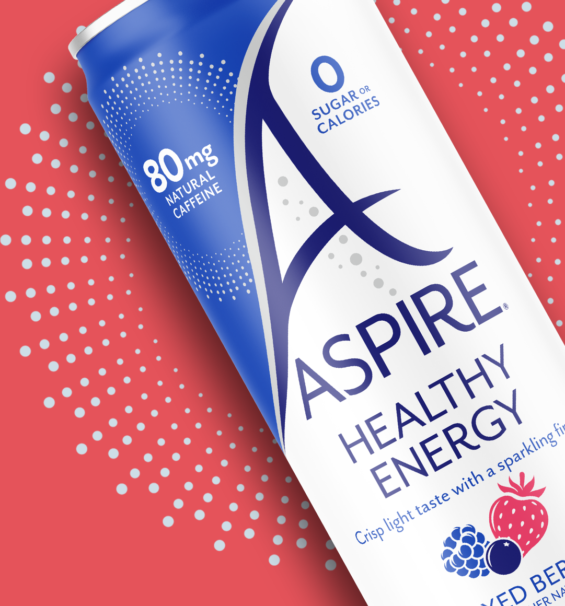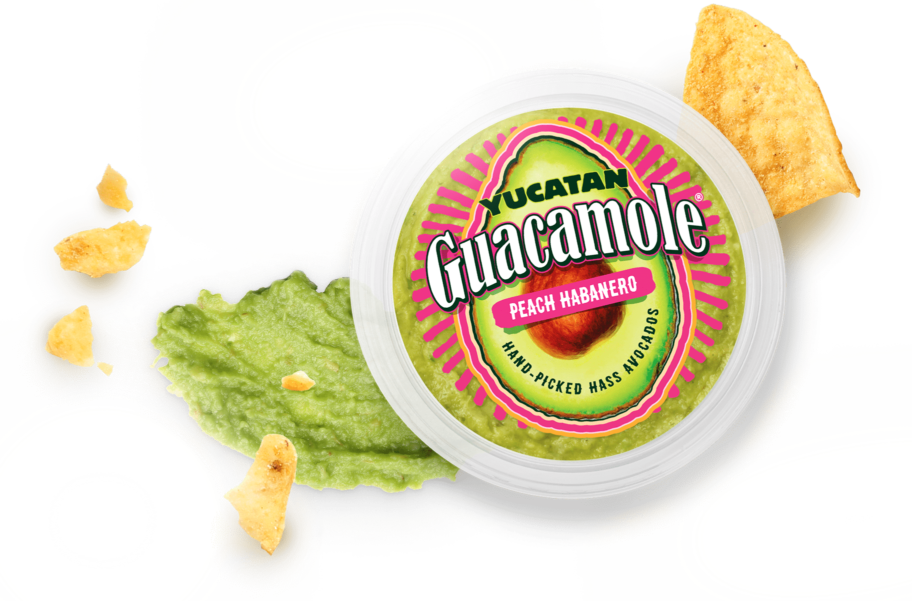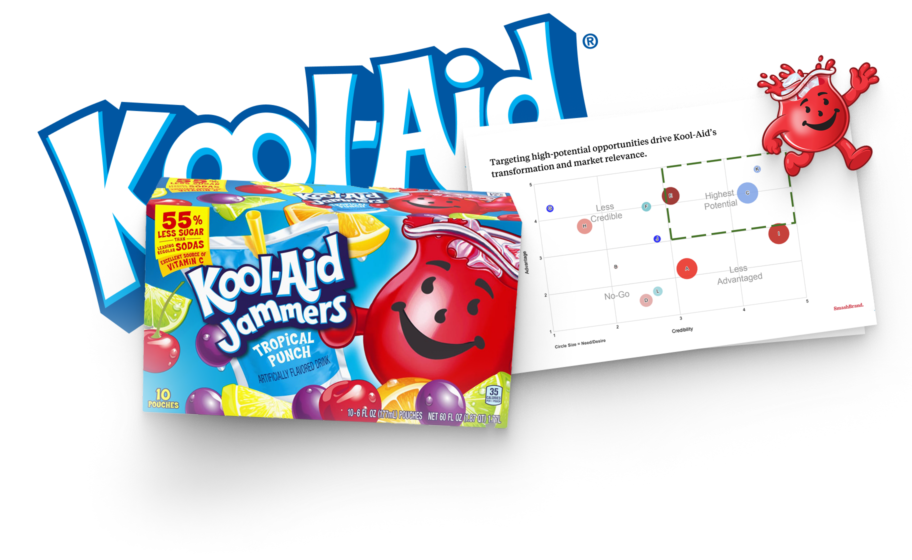Opening a shipping box is the moment your customer finally touches your brand. This is where your ecommerce packaging design becomes the most tangible brand experience, forms perception, shapes loyalty, and begins shareable moments. Strategic ecommerce packaging design blends custom packaging, structural integrity, and storytelling to reinforce your brand identity.
Impactful packaging design reduces returns and transforms unboxing into brand-building moments when it arrives at doorsteps. Unlike retail packaging, ecommerce packaging must endure fulfillment, wow customers at home, and drive repeat purchases while aligning with sustainable packaging demands.
In this article, you will explore how effective packaging design drives growth. You will learn what most ecommerce brands overlook, how to fix it, and how to turn your product packaging into a commerce advantage.
The importance of strategic packaging design in e-commerce.
In the ecommerce ecosystem, packaging is a pivotal touchpoint that significantly influences the customer journey from warehouse to doorstep. Without the tactile experience of in-store shopping, ecommerce packaging design becomes the primary medium through which customers interact with a brand physically.
The Packaging Journey: From Warehouse to Doorstep
- First impressions: When customers receive a shipping box, their perception of the brand begins to form. A well-designed custom packaging solution can evoke excitement and anticipation, setting a positive tone for the unboxing experience.
- Perceived value: High-quality packaging materials and thoughtful design elements can elevate a product’s perceived value, reinforcing the brand’s commitment to quality and attention to detail.
- Return rates: Effective secondary packaging that ensures product integrity during transit can reduce the likelihood of returns due to damage, thereby enhancing customer satisfaction and trust.
- Unboxing and shareability: Unique, cohesive, and branded packaging can facilitate a memorable unboxing experience, encourage customers to share their experiences on social media, amplify brand recognition, and attract new customers.
Through smart packaging strategies that align with the brand’s identity and values, businesses can create meaningful connections with customers, foster loyalty, and drive growth in the competitive e-commerce landscape.
What strategic ecommerce packaging design means.
The primary purpose of strategic e-commerce packaging is to perform well at the doorstep and in the first interaction. Your strategy must begin with the consumer and end with results. This means every packaging decision must be driven by what real people do, say, and feel, instead of assumptions.
A consumer-centric design process leverages behavioral data and hands-on consumer feedback to ensure that every element, from packaging material to unboxing flow, enhances the customer experience. If your packaging doesn’t resonate with how customers shop, share, and repurchase, it’s not strategic.
Brands must validate performance through testing. They must stress-test their innovative packaging prototypes in fulfillment scenarios and evaluate with real consumers. That’s the difference between artful guessing and results-driven execution.
Every choice from brand colors to structural form reinforces your brand image and extends your brand strategy. Unfortunately, many brands prioritize unique packaging that’s beautiful but ineffective, overdesigned formats, excess secondary packaging, or materials that increase packaging waste and ignore the potential of recycled materials.
Core elements that drive ecommerce packaging performance.
E-commerce brands need a packaging strategy that drives real-world results. It must convert attention into action and ensure every touchpoint works harder across the buying journey. Here’s how the core elements of product packaging design deliver measurable impact.
Protection that builds trust.
When a customer opens a damaged product, the relationship starts to crack. Protective packaging is the frontline defense in building reliability. E-commerce brands can’t afford fragile designs or materials that buckle in transit.
Your shipping boxes and internal structures must withstand drops, pressure, and delays without sacrificing brand feel. The right balance between durability and visual appeal can be the difference between a returned product and a repeat customer.
Design that commands attention.
E-commerce packages land at doorsteps, not store shelves. That means the visual strategy must activate excitement the moment it arrives. Strategic use of brand colors, smart printing choices, and textures creates instant recognition and amplifies brand awareness. More importantly, they feed into shareability. Whether an Instagram story or an unboxing video, design must hold up visually and emotionally across every screen and platform.
Messaging that converts.
Most packaging tries to say too much or says the wrong thing altogether. High-performance product packaging design uses clear, concise messaging that supports the brand’s voice and eliminates friction. When your packaging speaks directly to what customers care about, it increases retention and strengthens brand perception. That is especially critical in a space where the unboxing moment often replaces in-store consultation.
Sustainability that resonates
Consumers are highly attuned to environmental cues. Integrating recycled material, minimizing plastic packaging, and using eco-friendly packaging builds credibility and appeals to modern values. And when sustainability is authentic to your brand, it stops being a side note and starts being a growth lever.
Efficiency that scales
Growth demands systems that scale. Packaging should streamline the logistics chain, not complicate it. Overdesigned formats that work in a photo shoot but fail in a fulfillment center are common pitfalls. Optimized sizing, simplified assemblies, and cost-effective material use reduce friction across production and delivery. Efficiency is invisible to the customer, but critical for scalability and a fundamental part of strategic packaging strategy.
Packaging as a data-driven growth engine.
In connected commerce, packaging transcends its traditional role. It evolves into a strategic asset that drives growth and enhances customer engagement. For an e-commerce business, the packaging experience is often the first physical interaction a customer has with the brand, making it a critical touchpoint for influencing brand perception and fostering loyalty.
Reducing customer acquisition costs through enhanced retention.
Acquiring new customers is significantly more expensive than retaining existing ones. Strategic packaging is pivotal in customer retention by delivering a memorable unboxing experience that reinforces brand values and encourages repeat purchases. Incorporating elements like a well-crafted packaging insert can personalize the experience, making customers feel valued and more likely to return.
The use of eco-friendly packaging resonates with environmentally conscious consumers, strengthening their connection to the brand. Brands that adopt sustainable packaging practices appeal to this growing demographic and position themselves as responsible and forward-thinking, further enhancing customer loyalty.
Amplifying word-of-mouth through unboxing experiences.
A thoughtfully designed unboxing experience can transform customers into brand advocates. When packaging aesthetics are aligned with brand identity and values, customers are more inclined to share their experiences on social media platforms, generating organic word-of-mouth promotion.
This user-generated content serves as authentic endorsements, expanding brand reach and attracting new customers without additional marketing expenditure. Implementing frustration-free packaging enhances the customer experience and encourages positive reviews and shares, as customers appreciate the ease and thoughtfulness of the packaging design.
Minimizing returns through clear communication and protection.
Product returns can erode profit margins and damage brand reputation. Effective packaging mitigates this risk by ensuring product protection during transit and providing clear, concise information that sets accurate customer expectations. Utilizing durable materials like corrugated cardboard and minimizing excess packaging demonstrates a commitment to sustainability.
Clear labeling and informative packaging inserts can address common customer queries, reducing confusion and the likelihood of returns. By proactively communicating product features and care instructions, brands can enhance customer satisfaction and decrease return rates.
Why do most brands miss the mark?
Many ecommerce brands unknowingly handicap their growth by approaching packaging with the wrong mindset. Instead of treating it as a high-impact performance lever, they rely on assumptions, follow trends, or default to aesthetics, resulting in missed opportunities and underwhelming results.
First, many brand owners design packaging based on internal opinions or outdated benchmarks rather than real consumer behavior. Even the most attractive packaging design can fail without validated feedback or user testing. Whether baby food packaging design or perfume packaging, performance turns a product into a category leader.
From the moment a box arrives, it shapes perception, retention, and repeat purchase. Yet, brands often skimp on what could be a conversion tool, missing out on the long-term gains that come from thoughtful investment.
Lastly, brands often chase trends in packaging aesthetics at the expense of function. A minimal box might look great on a concept board but fail in the real world. Frustration-free packaging often wins more loyalty than overengineered “wow” moments that frustrate the consumer.
At SmashBrand, we close these gaps with a test-first, performance-driven approach. Our process integrates consumer testing at every phase, from visual strategy to physical store simulation, so we don’t guess what works; we prove it. We build packaging that performs, not just pleases.
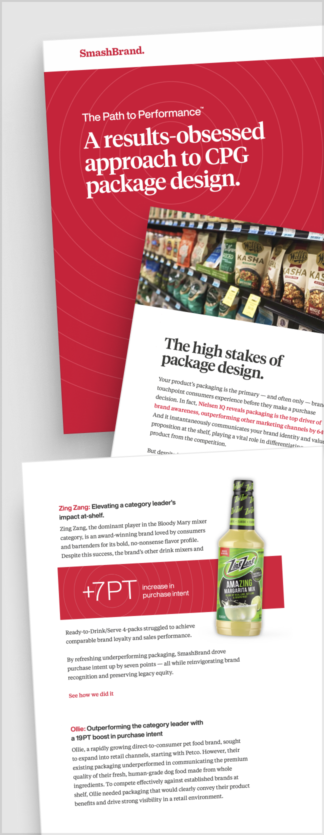
Path to Performance™
Taking a results-obsessed approach to CPG package design.
Learn how SmashBrand’s proprietary process – rooted in scientific principles, informed by data, and validated by your target audience – takes the guesswork out of package design and delivers guaranteed results.
How to think and design ecommerce packaging strategically.
Most packaging decisions begin with internal opinions and end with missed growth opportunities. Strategic thinking flips that script; it replaces guesswork with consumer insight, aesthetics with performance, and static packaging with scalable growth tools. Here’s how to shift into that mindset.
Audit the emotional and functional impact.
Start by assessing what your packaging communicates. Does it reflect your brand promise? Does it create a memorable unboxing experience or just deliver a product? Review how your e-commerce assets, from box design to inserts, contribute to (or detract from) the customer journey. Evaluate not just looks but protection, messaging, and shareability.
Collect honest consumer feedback.
Internal alignment is helpful, but consumer input drives results. Strategic packaging design is built on actual reactions, not assumptions. Use testing methods like first-impression studies or in-home usage tests to uncover how your packaging performs in real-world scenarios. You’ll often find that what impresses a team doesn’t always engage a customer.
Benchmark against competitors.
Your packaging doesn’t operate in a vacuum. Compare it to direct and indirect competitors, especially those winning in the unboxing and retention game. A sharp competitor analysis highlights opportunity gaps and informs your brand identity agency or design team on how to differentiate with intent.
Prototype with intent, not guesswork.
Before you invest in full production, treat package design like a product. Develop iterations that test both function and form. This is where preproduction services come into play, refining everything from material feel to message clarity based on consumer response. It’s more than tweaking; it’s designing for market success.
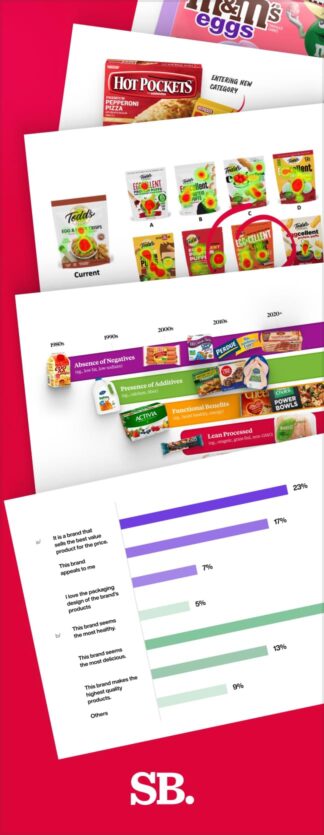
Nice Package
Don’t miss out on our monthly newsletter Nice Package!
Each month, we deliver a data-driven newsletter directly to your inbox, unpacking a critical topic in the FMCG & CPG industry.
"*" indicates required fields
Data-Driven Brand Development
Looking for a packaging design company that delivers more than promises? SmashBrand integrates strategy, testing, and design to create packaging that wins at shelf and accelerates sales. We back it with data and a guarantee. Don’t gamble with your brand. Choose a partner obsessed with performance.
Subscribe to
Nice Package.
A monthly newsletter that unpacks a critical topic in the FMCG & CPG industry.
Free Resource.
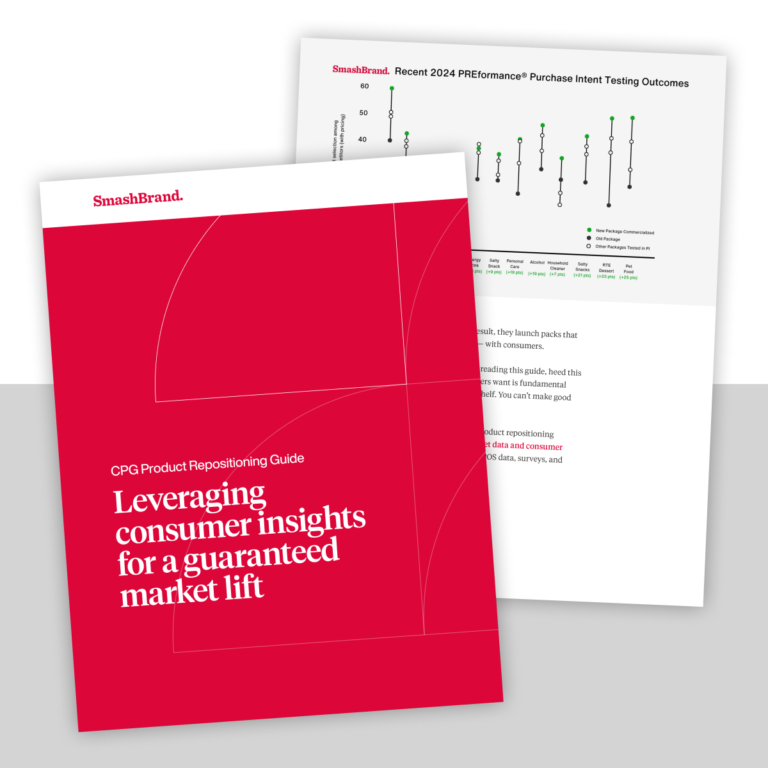
CPG product repositioning guide.
Explore the five undeniable signs your CPG product needs repositioning along with strategies for leveraging consumer insights for a guaranteed market lift.
Learn More About CPG product repositioning guide.
